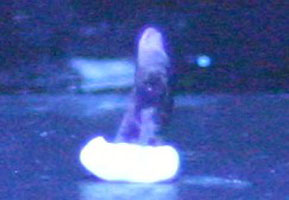Creodonts were widely distributed during the Cenozoic era, appearing in the mid-Paleocene. They had mostly disappeared by the mid-Eocene. Only Hyaenodon was left at the end of the Eocene (40 MYA).
The Hyaenodontidae were the last surviving family of the order of carnivorous mammals known as Creodonta. Hyaenodons were the most specialized creodonts and were the most widely dispersed predators of the White River Badlands. As with other predators, Hyaenodon fossils are not commonly found.
Hyaenodon is Latin for hyaena tooth. In Latin cruentus or crucians means torture or hard violence. Hyaenodons (Hyaenodon cruentus) ranged in size, from a domestic dog to a grey wolf. They were primative carnivores and their teeth were adapted to eating meat, but were less specialized than true carnivores.
Hyaenodon competed with other carnivores, such as nimravids (saber-toothed like cats), for similar species of prey. Without binocular vision, they may have been at a disadvantage when competing with these other predators and some paleontologists feel that they were scavangers like present day hyaenas. The observation has been made that there are as many species of Hyaenadons as there are species of oreodonts. The oreodonts were likely their favorite prey and when they disappeared, so did the Hyaenodons (by the end of the Oligocene - 37.5-26 MYA).
Because of replacement minerals, most of the fossil mammal teeth from the White River Formation of South Dakota will fluoresce to some degree. The teeth are usually replaced by calcite, which will fluoresce a yellow to yellow-orange. Any green showing up on the specimen is usually chalcedony and is usually part of the bone or bone marrow. On a few specimens there may be a bright green at the base of the specimen this will be an oil based clay holding up the specimen. Any purple on the specimen is the UV light reflecting off the light colored areas of the specimen and is not fluorescence. The fossil teeth from South Dakota will fluoresce under either long or short wave, but they fluoresce best under both at the same time. You may see a photo of some of the specimens under normal light by returning to the main fluorescent page and clicking on the link "to view specimen material from South Dakota." You may also view all teeth by going to the fossil teeth page and then to the appropriate page for the teeth you want to view. The item number will be the same as the number in the fluorescent section without the "F" at the end of the number.
Specimen is a front tooth, possibly and incisor or canine.
Kingdom: Animalia, Phylum: Chordata, Class: Mammalia, Order: Creodontidae, Family: Hyaenodontidae, Genus: Hyaenodon, Species: cruentus.
This specimen is no longer available! It was offered at $10.00.
Dog - Hyaenodon cruentus 
Quantity in Basket: None
Code: TSDG-104F
Price: $0.00
Shipping Weight: 0.19 pounds
Time: Early Eocene through Early Oligocene, approximately 40 - 30 million years ago.
Location: White River Formation, South Dakota Badlands, USA
Dimensions: 1/2" x 3/16" x 1/8"